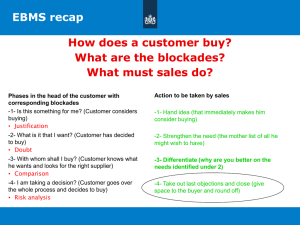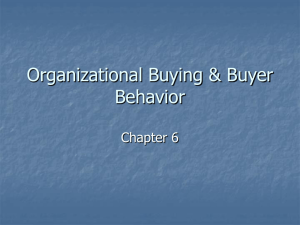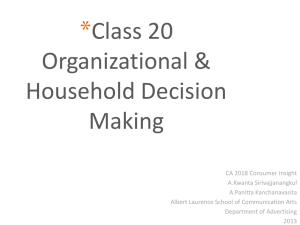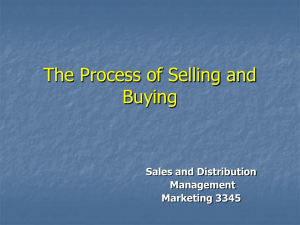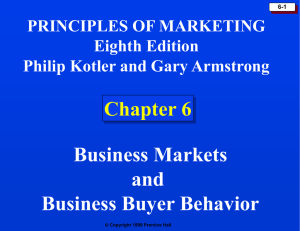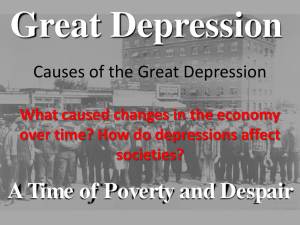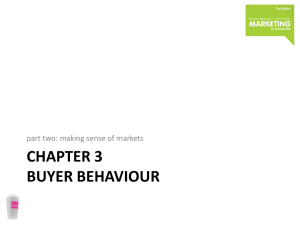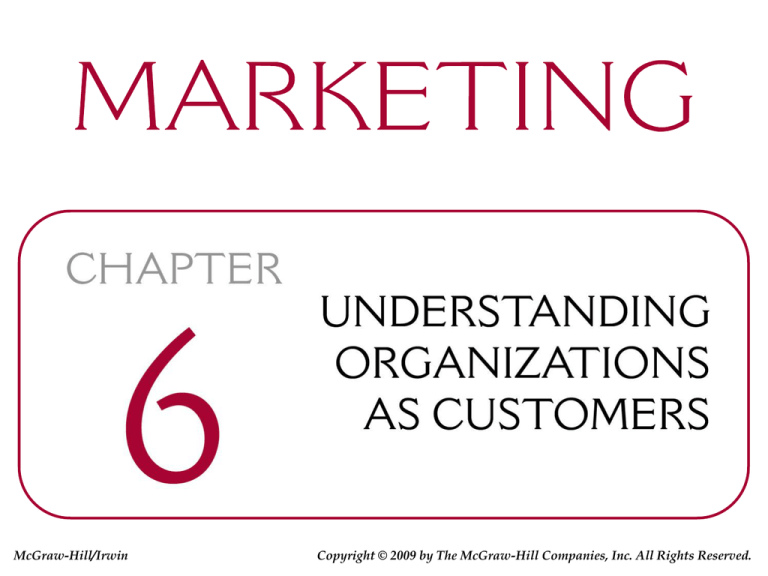
McGraw-Hill/Irwin
Copyright © 2009 by The McGraw-Hill Companies, Inc. All Rights Reserved.
LEARNING OBJECTIVES (LO)
AFTER READING CHAPTER 6, YOU SHOULD BE ABLE TO:
LO1
LO2
Distinguish among industrial, reseller,
and government organizational
markets.
Describe the key characteristics of
organizational buying that make it
different from consumer buying.
6-2
LEARNING OBJECTIVES (LO)
AFTER READING CHAPTER 6, YOU SHOULD BE ABLE TO:
LO3
LO4
Explain how buying centers and
buying situations influence
organizational purchasing.
Recognize the importance and nature
of online buying in industrial, reseller,
and government organizational
markets.
6-3
BUYING PAPER IS A GLOBAL
BUSINESS DECISION AT JCPENNEY
6-4
LO1
THE NATURE AND SIZE OF
ORGANIZATIONAL MARKETS
Business Marketing
Organizational Buyers
• Industrial Markets
(Industrial Firms)
• Reseller Markets
(Resellers)
• Government Markets
(Government Units)
Wholesalers
Retailers
Global Organizational Markets
6-5
THE NATURE AND SIZE OF
ORGANIZATIONAL MARKETS
• Business Marketing
– Marketing of goods and services to
companies, governments, and not-for-profit
organizations for use in the creation of
goods and services that they can produce
and market to others.
Slide 6-6
THE NATURE AND SIZE OF
ORGANIZATIONAL MARKETS
•
Organizational Buyers
–
Manufacturers, wholesalers, retailers, and
government agencies that buy goods and
services for their own use or for resale.
– Include all buyers in a nation except ultimate
consumers
– Total annual purchases of organizational
buyers are far greater than those of ultimate
consumers
– Divided into three different markets:
1) Industrial Markets
2) Reseller Markets
3) Government Markets
Slide 6-6
THE NATURE AND SIZE OF
ORGANIZATIONAL MARKETS
1. Industrial Markets (Industrial Firms)
– In some way reprocess a product or
service before selling it again to the next
buyer
– Approximately 12M firms
– Predominately Service firms (approx
74%)
Slide 6-6
THE NATURE AND SIZE OF
ORGANIZATIONAL MARKETS
2. Reseller Markets (Resellers)
– Buy physical products and resell them
without any reprocessing
• Wholesalers (approx 860,000)
• Retailers (approx 3M)
Slide 6-6
THE NATURE AND SIZE OF
ORGANIZATIONAL MARKETS
3. Government Markets (Government
Units)
– Federal, state, and local agencies that
buy goods and services for the
constituents they serve (approx 88,000 )
Slide 6-6
FIGURE 6-A Type and number of
organization establishments in the U.S.
6-11
THE NATURE AND SIZE OF
ORGANIZATIONAL MARKETS
• Global Organizational Markets
– Industrial, Reseller, and Government
markets
– Largest exporting industries in U.S. focus
on organizational customers, not ultimate
consumers
Slide 6-6
LO1
MEASURING DOMESTIC AND GLOBAL
INDUSTRIAL, RESELLER, AND
GOVERNMENT MARKETS
North American
Industry
Classification
System (NAICS)
6-13
North American Industry
Classification System (NAICS)
• Common industry classifications for Canada,
Mexico, and the United States
• Easier measurement of economic activity in
member countries of NAFTA
• Replaced Standard Industrial Classification
(SIC)
Slide 6-9
FIGURE 6-1 NAICS breakdown for the
information industries sector:
NAICS code 51 (abbreviated)
6-15
LO1
MEASURING DOMESTIC AND GLOBAL
INDUSTRIAL, RESELLER, AND
GOVERNMENT MARKETS
North American
Product
Classification
System (NAPCS)
6-16
Concept Check
1. What are the three main types of
organizational buyers?
A: Industrial Firms; Resellers;
Government Units
Slide 6-11
Concept Check
2. What is the North American Industry
Classification System (NAICS)?
A: The NAICS provides common
industry definitions for Canada,
Mexico, and the United States, which
makes easier the measurement of
economic activity in the three
member countries of NAFTA.
Slide 6-12
CHARACTERISTICS OF
ORGANIZATIONAL BUYING
LO2
Derived Demand
Size of Order or Purchase
Number of Potential Buyers
Organizational Buying Objectives
6-19
CHARACTERISTICS OF
ORGANIZATIONAL BUYING
Derived Demand
Refers to the linkage between consumer
demand for a company’s output and its
purchases of business products.
Demand for industrial products and
services is driven by, or derived from,
demand for consumer products and
services
Derived demand ultimately affects capital
items and expense items.
Slide 6-13
CHARACTERISTICS OF
ORGANIZATIONAL BUYING
• Size of the Order or Purchase
– Typically much larger than consumer
• Number of Potential Buyers
– Far fewer than consumer
• Organizational Buying Objectives
– Help them achieve their objectives
Slide 6-13
FIGURE 6-2 Key characteristics and
dimensions of organizational buying
behavior
6-22
CHARACTERISTICS OF
ORGANIZATIONAL BUYING
LO2
Organizational Buying Criteria
ISO 9000
Supplier Development
6-23
CHARACTERISTICS OF
ORGANIZATIONAL BUYING
Organizational Buying Criteria
Slide 6-16
CHARACTERISTICS OF
ORGANIZATIONAL BUYING
•
Organizational Buying Criteria
–
The objective attributes of the supplier’s
products and services and the capabilities of
the supplier itself
1.
2.
3.
4.
5.
6.
7.
Price
Ability to meet quality specifications
Ability to meet required delivery schedules
Technical capability
Warranties and claim policies
Past performance on previous contracts
Production facilities and capacity
Slide 6-16
FIGURE 6-B Key organizational buying
criteria
6-26
MARKETING MATTERS
Harley-Davidson’s Supplier Collaboration
Creates Customer Value…and a Great Ride
6-27
LO2
CHARACTERISTICS OF
ORGANIZATIONAL BUYING
ISO 9000
6-28
LO2
CHARACTERISTICS OF
ORGANIZATIONAL BUYING
Supplier Development
6-29
LO2
CHARACTERISTICS OF
ORGANIZATIONAL BUYING
Buyer-Seller
Relationships
and Supply Partnerships
1. Reciprocity
2. Supply Partnership
6-30
CHARACTERISTICS OF
ORGANIZATIONAL BUYING
1. Reciprocity
Practice of buying from suppliers who are
also customers
Controversial practice in number of
organizational situations
Suggest close links among participants and
can add to complexity of B2B buying
behavior
Can be viewed by Government as attempts
to reduce competition
Slide 6-13
ETHICS AND SOCIAL
RESPONSIBILITY ALERT
Scratching Each Other’s Back:
The Ethics of Reciprocity in
Organizational Buying
Slide 6-20
CHARACTERISTICS OF
ORGANIZATIONAL BUYING
2. Supply Partnerships
Buyers and sellers adopt mutually beneficial
objectives, policies, and procedures for the
purpose of lowering the cost or increasing
the value of products and services delivered
to the ultimate consumer.
Just-In-Time Inventory (JIT)
Slide 6-19
CHARACTERISTICS OF
ORGANIZATIONAL BUYING
LO3
THE BUYING CENTER—A CROSS-FUNCTIONAL GROUP
Buying Center
Buying Committee
People in the Buying Center
Roles in the Buying Center
6-34
CHARACTERISTICS OF
ORGANIZATIONAL BUYING
• The Buying Center: A CrossFunctional Group
– Several people in the organization that
participate in the buying process.
– Share common goals, risks, and
knowledge important to a purchase
decision.
Slide 6-22
BUYING CENTER CONCEPT
• Provides a vital model for understanding
organizational buying behavior.
• Encompasses everyone who is involved in
any aspect of its buying action.
• Not part of a firm’s formal organization
structure – informal and variable in size and
composition
• However, may be formalized – Buying
Committee
Slide 6-22
Buying Center
Who is in the buying center and
what roles do they play?
Slide 6-23
Buying Center Roles
Users are people who actually use the product.
Influencers affect the buying decision by supplying
information to guide evaluation of alternatives or by
setting buying specifications.
The Decider actually chooses a good or service,
although another person may have the formal
authority to do so.
The Buyer actually has the formal authority to select
a supplier and to implement the procedures for
securing the good or service. Always included in
Buying Center.
Gatekeepers control the information that all buying
center members will review.
CHARACTERISTICS OF
ORGANIZATIONAL BUYING
THE BUYING CENTER—A CROSS-FUNCTIONAL GROUP
Buying Situations (Buy Classes) and
the Buying Center
Straight Rebuy
Modified Rebuy
New Buy
Slide 6-25
Three General Categories of
Business Buying Situations
1. Straight Rebuy
•
The simplest buying situation is a straight rebuy, a recurring
purchase decision in which an existing customer places a new order.
2. Modified Rebuy
•
•
A purchaser is willing to reevaluate available options. The decision
makers see some advantage in looking at alternative offerings.
Perceived quality and cost differences can also provoke modified
rebuys.
3. New Buy
•
•
•
The most complex category of business buying—first time or unique
purchase situations that require considerable effort.
Often requires a purchaser to carefully consider alternative offerings
and vendors.
Buying center enlarged to include all who have stake in the new buy.
Concept Check
1. What one department is almost
always represented by a
person in the buying center?
A: Purchasing Department
Slide 6-27
Concept Check
2. What are the three types of
buying situations or buy
classes?
A: straight rebuy; modified rebuy;
new buy
Slide 6-28
FIGURE 6-3 The buying situation affects
buying center behavior in different ways
6-43
CHARTING THE ORGANIZATIONAL
BUYING PROCESS
• Organizational Buying Behavior
– The decision-making process that
organizations use to establish the need for
products and services and identify,
evaluate, and choose among alternative
brands and suppliers
Slide 6-29
CHARTING THE ORGANIZATIONAL
BUYING PROCESS
• Stages in the Organizational Buying
Process
Slide 6-29
Machine Vision System
What is its organizational buying process?
Slide 6-33
CHARTING THE
ORGANIZATIONAL BUYING PROCESS
LO3
STAGES IN BUYING A MACHINE VISION SYSTEM
Organizational
Buying Behavior
for a Machine
Vision System
Stage 1: Problem Recognition
•Make-Buy Decision - evaluation of whether components
and assemblies will be purchased from outside or built within
6-47
CHARTING THE
ORGANIZATIONAL BUYING PROCESS
LO3
STAGES IN BUYING A MACHINE VISION SYSTEM
Organizational
Buying Behavior
for a Machine
Vision System
Stage 2: Information Search
• Purchasing Databank
•Value Analysis – systematic appraisal of the design, quality,
and performance of a product to reduce costs
6-48
CHARTING THE
ORGANIZATIONAL BUYING PROCESS
LO3
STAGES IN BUYING A MACHINE VISION SYSTEM
Stage 3: Alternative Evaluation
•Price, quality, delivery, service, assurance
that the supplier will not go out of business
•Bidder’s List - list of firms believed to be qualified
to supply a given item
6-49
FIGURE 6-5 Product and supplier selection
criteria for buying machine vision
equipment emphasize factors other than
price
Percentage of machine vision buyers citing
individual selection criteria
6-50
LO3
CHARTING THE
ORGANIZATIONAL BUYING PROCESS
STAGES IN BUYING A MACHINE VISION SYSTEM
Stage 4: Purchase Decision
Stage 5: Postpurchase Behavior
Formal product acceptance
process
6-51
CHARTING THE ORGANIZATIONAL
BUYING PROCESS
Four lessons for marketers who
want to increase chances of selling
products and services to
organizations.
Firms must:
1.
2.
3.
4.
Understand organization’s needs
Get on the right bidder’s list
Find the right people in the buying center
Provide value to organizational buyers
Slide 6-25
FIGURE 6-4 Comparing the stages in a
consumer and organizational purchase
decision process
6-53
Concept Check
1. What is a make-buy decision?
A: An evaluation of whether components
and assemblies will be purchased from
outside suppliers or built by the
company itself.
Slide 6-34
Concept Check
2. What is a bidder’s list?
A: A list of firms believed to be
qualified to supply a given item.
Slide 6-35
ONLINE BUYING IN
ORGANIZATIONAL MARKETS
LO4
Prominence of Online Buying
in Organizational Markets
E-marketplaces
Online Auctions in
Organizational Markets
Traditional Auction
Reverse Auction
6-56
ONLINE BUYING IN
ORGANIZATIONAL MARKETS
E-marketplaces are online trading
communities that bring together
buyers and supplier organizations to
make possible the real time exchange
of information, money, products, and
services.
Slide 6-36
ONLINE BUYING IN
ORGANIZATIONAL MARKETS
A traditional auction is an online
auction in which a seller puts an item
up for sale and would-be buyers are
invited to bid in competition with each
other.
Slide 6-36
ONLINE BUYING IN
ORGANIZATIONAL MARKETS
A reverse auction is an online auction
in which a buyer communicates a
need for a product or service and
would-be suppliers are invited to bid
in competition with each other.
Slide 6-36
FIGURE 6-6 How buyer and seller
participants and price behavior differ by
type of online auction
6-60
Business Marketing
Business marketing involves the
marketing of goods and services
to companies, governments, or
not-for-profit organizations for use
in the creation of goods and
services that they can produce
and market to others.
6-61
Organizational Buyers
Organizational buyers are those
manufacturers, wholesalers,
retailers, and government
agencies that buy goods and
services for their own use or for
resale.
6-62
North American Industry
Classification System (NAICS)
The North American Industry
Classification System (NAICS) provides
common industry definitions for Canada,
Mexico, and the United States, which
makes easier the measurement of
economic activity in the three member
countries of the North American Free Trade
Agreement (NAFTA).
6-63
Derived Demand
Derived demand is the demand
for industrial products and
services is driven by, or derived
from, demand for consumer
products and services.
6-64
Organizational Buying Criteria
Organizational buying criteria
are the objective attributes of the
supplier’s products and services
and the capabilities of the supplier
itself.
6-65
ISO 9000
ISO 9000 consists of standards
for registration and certification of a
manufacturer’s quality management
and assurance system based on an
on-site audit of practices and
procedures developed by the
International Standards Organization
(ISO).
6-66
Supplier Development
Supplier development is the
deliberate effort by organizational
buyers to build relationships that
shape suppliers’ products,
services, and capabilities to fit a
buyer’s needs and those of its
customers.
6-67
Reciprocity
Reciprocity is an industrial
buying practice in which two
organizations agree to purchase
each other’s products and
services.
6-68
Supply Partnership
Supply partnership is a relationship
that exists when a buyer and its
supplier adopt mutually beneficial
objectives, policies, and procedures
for the purpose of lowering the cost
or increasing the value of products
and services delivered to the ultimate
consumer.
6-69
Buying Center
A buying center consists of a
group of people in an organization
who participate in the buying
process and share common goals,
risks, and knowledge important
to a purchase decision.
6-70
Buy Classes
Buy classes consists of three
types of organizational buying
situations: straight rebuy, new buy,
and modified rebuy.
6-71
Organizational Buying Behavior
Organizational buying behavior
is the decision-making process
that organizations use to establish
the need for products and services
and identify, evaluate, and choose
among alternative brands and
suppliers.
6-72
Make-Buy Decision
A make-buy decision involves an
evaluation of whether components
and assemblies will be purchased
from outside suppliers or built by
the company itself.
6-73
Value Analysis
Value analysis involves a
systematic appraisal of the design,
quality, and performance of a
product to reduce purchasing
costs.
6-74
Bidder’s List
A bidder’s list is a list of firms
believed to be qualified to supply
a given item.
6-75
E-marketplaces
E-marketplaces are online trading
communities that bring together
buyers and supplier organizations to
make possible the real time exchange
of information, money, products, and
services. Also called B2B exchanges
or e-hubs.
6-76
Traditional Auction
A traditional auction is, within
an e-marketplace, an online
auction in which a seller puts an
item up for sale and would-be
buyers are invited to bid in
competition with each other.
6-77
Reverse Auction
A reverse auction is, within an
e-marketplace, an online auction
in which a buyer communicates a
need for a product or service and
would-be suppliers are invited to
bid in competition with each other.
6-78

